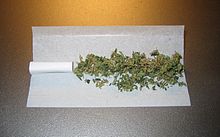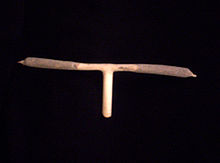joint
A joint (also known as a bag ) is a piece of paper filled with cannabis products (mostly hashish or marijuana ) that is twisted together in order to smoke it. In Germany, these cannabis products are often mixed with tobacco or, more rarely, with Knaster beforehand . In many other countries, however, cannabis is mainly used neat, i. H. smoked without added tobacco.
Other intoxicating substances can also be consumed in a joint, such as heroin , cocaine , opium, or methamphetamine . However, this is rather unusual.
Word origin
The word joint comes from French . It is derived from the old French joint “joint” from the Latin iunctus “joined, connected” to iungere “to join together, connect”. From 1877 on, this slang expression, developed in America , was used to describe a building or operation, particularly with reference to an opium den . In 1935 the term was used to refer to the hypodermic needles used to inject heroin and other drugs. In 1938 the term was first used in the sense of “marijuana cigarette”.
The term spliff , which also describes a joint, is a word of West Indian origin. It has spread to several western countries, particularly the continents of Europe and North America . However, the exact etymology is not known. The term is attested as early as 1936.
There are countless alternative names and scene names for the joint, which are used both for discretion and as a nickname and are partly strongly influenced by the local color . They often refer to the shape ("bag") or are to be understood metaphorically.
Many synonyms are also used for actually smoking a joint. One of the most commonly used for this is smoking weed .
Appearance
Most of the time, a joint is funnel-shaped ( conical ) and thicker at the smoldering end. The active ingredient content in the form of tetrahydrocannabinol (THC) can vary greatly depending on the amount, variety and quality of the cannabis . The amount of hashish or marijuana used varies between one or more tenths of a gram and several grams.
A mouthpiece , usually called a filter or tip , is often attached to the thin end , in the form of a small cardboard tube (for example made from the cardboard of a cigarette box, train and bus tickets or an index card, but usually from specially produced and in tobacco shops and filter tips available at kiosks). This increases the stability and grip of the joint. The length of the filter also serves to cool the smoke. Special tip tubes can also be used for this purpose, which are enriched with activated carbon as required . The activated carbon should filter pollutants from the (tobacco) smoke, but let the active ingredient THC through.
Rotate
For rolling the joint there are special cigarette papers from different manufacturers that vary in length, width and paper texture . Usually long papers (extra- long cigarette papers ) or rips (brand name; endless papers from the roll) are used. Alternatively, several normal cigarette papers can be glued together to form a larger one (two-sheet, three-sheet, ...); several long papers can also be connected (e.g. L-sheet).
Another method is plugging. The paper with the filter without cannabis or tobacco is turned in front of it, in order to then stuff the marijuana or the mixture into it with a thin object. There are empty pre-rolled papers in joint form (so-called cones ), for example with sturdy plastic filters or with active filters, to buy in so-called head shops . A joint can also be made with a special lathe.
In the Dutch coffee shops you can buy pre-rolled joints, usually a mixture of different waste residues of marijuana.
Variations
A joint can be rolled in different ways: Usually, the cigarette paper is rolled around the contents with the sticky side up, as with hand-rolled cigarettes. In the Dutch way, also known as inside-out , the paper is placed so that the adhesive strip is facing down. Then it is screwed in and the paper is moistened on the adhesive side. Then the protruding part of the paper is burned away or torn off so that less paper has to be smoked.
Other joint types are:
- The mustache or helicopter ; two or three joints on a long tip with a hole cut in the middle for drawing.
- A tulip is a ball-shaped, short and extremely thick joint that is like a head on a very long tip.
- The windmill is a collection of four or more normal joints, summarized in one large tip, that are smoked synchronously.
- The diamond is a joint that splits in half in the middle and converges on both sides so that it is lit in one place, but two gluten are developed while smoking.
- A stick , also known as a sticky , agent or spy , is a small joint that is rolled from a short cigarette paper and shaped like an ordinary, hand-rolled cigarette. The filter and the tobacco from an ordinary cigarette can also be unscrewed; finished cigarette tubes, rolling tobacco and a tamping machine are the most convenient tools. A stick or sticky is also simply a small and short joint.
- A blunt is rolled with a (possibly flavored) tobacco leaf, similar or analogous to that of a cigar . Such leaves have also been made from hemp for a number of years. Blunts are especially widespread in North America and are therefore usually smoked neat, as is customary there, without adding tobacco.
effect

The effects of a joint vary depending on the amount of THC and the quality of the cannabis product added. In the field test, a sensitization of all sensory organs, which began in the intoxication, was found remarkably often.
Legal aspects of cannabis
According to the provisions of the 1961 Single Convention on Narcotic Drugs , which was ratified by almost all countries in the world, the production, possession and trade of cannabis are almost worldwide prohibited, and in some countries its consumption is illegal. Exceptions are Spain and the Netherlands , for example , where the acquisition and possession of small amounts of cannabis (up to 5 grams) are tolerated and thus de facto exempt from punishment, although cannabis is still de jure illegal and prohibited in Spain and the Netherlands . In the United States of America , too , medical cannabis use is now legal in 33 of the 50 states, and recreational cannabis use is also legal in ten states and the federal capital Washington, DC .
Uruguay and Canada have fully legalized cannabis. In many other countries, the possession of a small amount of cannabis for personal use is partially decriminalized, with different amounts being considered small from country to country. In Austria and Germany, the mere consumption of cannabis or other narcotic drugs is de jure not punishable, on the other hand cultivation, manufacture, procuring, acquisition, possession, import, export and transit, sale, dispensing, Prescribing, administering and leaving for direct consumption is punishable under the Narcotics Act or subject to approval.
Consumption in Pop Culture
Cannabis is very common in European and American pop culture . Since the 1990s, cannabis use has been an issue with increasing frequency, especially in hip-hop and reggae music styles , as well as in films and literature. There are musicians whose lyrics largely deal with the use of cannabis, for example Afroman , Snoop Dogg , Devin the Dude and Cypress Hill . The same applies to “stoner films” such as Half Baked , How High or Harold & Kumar . In the process, consumption has become incidental among many consumers. In contrast, in the early days of cannabis use propagated through youth culture messages at the end of the 1960s / beginning of the 1970s, a more ritualized consumption could be observed. In addition, in the images of cannabis currently being conveyed, the drug's ostensible function as a symbol of rebellion in the “hippie era” has lost much of its effectiveness.
Web links
literature
- Lark-Lajon Lizermann: The cannabis cultivation: Everything about botany, cultivation, propagation, further processing and medical application as well as THC measurement methods. Nachtschatten Verlag, 2004, ISBN 3-03788-134-8 .
- Bernhard van Treeck: The great cannabis lexicon - everything about the useful plant hemp. Lexikon-Imprint-Verlag, Berlin 2000, ISBN 3-89602-268-7 .
- Hainer Hai, Ronald Rippchen: The HANF manual. Botany, chemistry, cultivation, harvest, global production & use as a fiber plant, cultural history of psychoactive hemp, ingestion, effects on head and body, experience reports, hemp in medicine, myths, hemp in road traffic, urine samples, the Dutch model, research today , The decriminalization and legalization debate . Pieper's MedienXperimente, Löhrbach 1998, ISBN 3-925817-73-5 . (The green branch 173)




